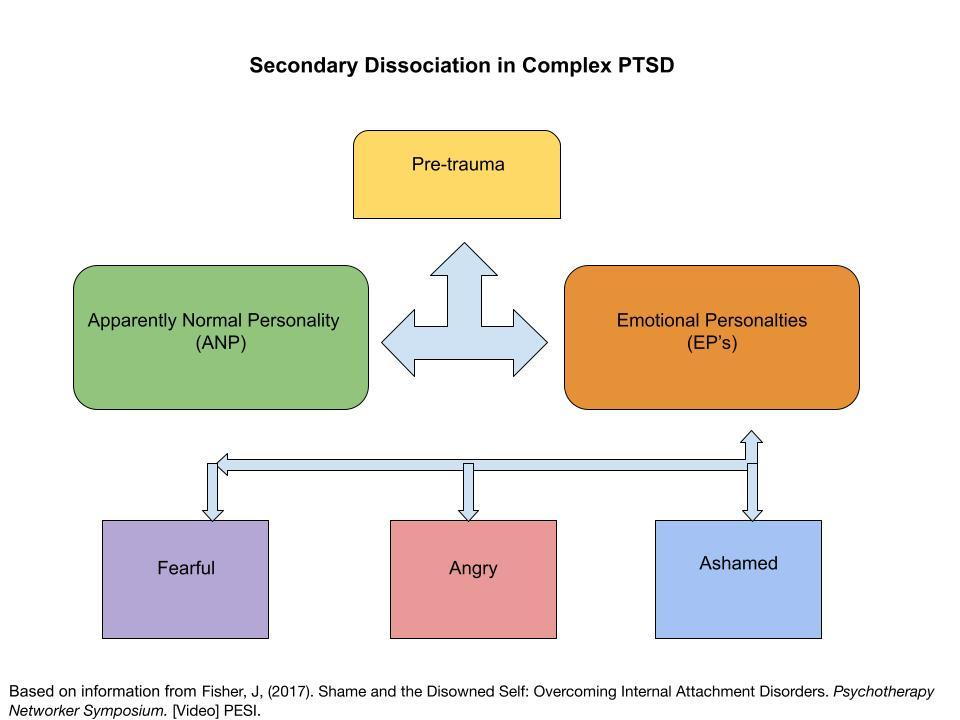
Photo by Fares Hamouche on Unsplash
Editor's Note: This article discusses reactions to trauma and may be triggering for some readers
"Yeah, dissociation, baby. That's what allows me to be talking to you and saying these things to you right now." – Stephanie Foo, 2022
It might surprise some people to learn that an award winning producer could suffer from PTSD, or more specifically, from Complex PTSD. Stephanie Foo endured ongoing emotional and physical abuse from her parents who later abandoned her at the age of thirteen. Although she achieved success, Foo describes herself as living with a constant fear "churning beneath the surface" (Aguilar, 2022).
How does someone who comes from such extreme trauma, living in constant hypervigilance, grow to become highly successful? The answer lies within the concept of dissociation and more specifically, the secondary dissociation that defines Complex Trauma.
With primary dissociation, a split in the self occurs following a single traumatic episode, forming an ANP and an EP (van der Hart, Nijenhuis, and Steele, 2006). The ANP's job is to get on with life (FIsher, 2017). To survive, it keeps trauma responses (the EP) at bay.
When a person survives multiple traumatic events, multiple EP's form. EP’s in secondary dissociation contain emotions and defense strategies used during original traumas. For example, one part might contain the fearful "flight" response someone used to hide when an abusive parent returned home. In addition to Complex PTSD, Secondary dissociation also plays a role in some forms of Borderline Personality Disorder and unspecified dissociative disorders (DESNOS).

Some EP’s may bear the hallmarks of hypoarousal. For example, an abused child may have frozen when faced with an adult attacker. That freeze response now returns when the adult gets triggered. As with primary dissociation, a more collapsed, hypoaroused presentation can develop in the ANP. Numbing becomes a primary strategy for keeping EP’s at bay.
Dividing off into parts helps people survive enduring childhood trauma. Disowning or alienating from parts becomes necessary. Many abusive parents do not welcome a child's natural angry, fight response. So, a child learns to bury and disconnect from their anger. But when these children reach adulthood, they often find their parts don't get along with one another. The angry part starts to come out and may sabotage the part that is trying to move on with life.
To help adult survivors of trauma, therapies for Complex PTSD prescribe re-aquainting a survivor with their disowned parts, becoming more integrated. A hypoaroused ANP could be one important key to helping survivors heal. Fisher (2017) acknowledges this part as the one trying to move on with normal life. When this part sees the value in making peace with disowned parts, people with Complex PTSD can move forward.
So far, I have discussed the phenomena of Primary and Secondary Dissociation in the Structural Dissociation of Personality (van der Hart, Nijenhuis & Steele, 2006). For each, I have described how hypoarousal can manifest in both the ANP and EP. Next, I discuss the third and final level of Tertiary Dissociation.
The content of this blog is for informational purposes only and is not intended to diagnose, treat, cure, or prevent any condition or disease. This blog is not intended as a substitute for consultation with a licensed practitioner. Please consult with your own therapist or healthcare provider regarding any suggestions and/or recommendations made in this blog. Although the author has made every effort to ensure that the information in this blog was correct at publication time and while this publication is designed to provide accurate information in regard to the subject mater covered, the author assumes no responsibility for errors, inaccuracies, omissions, or any other inconsistencies herein and hereby disclaim any liability to any party for any loss, damage, or disruption caused by errors or omissions. Unless otherwise indicated by name or direct reference, any resemblance to persons, living or dead, or actual events is purely coincidental. The use of this blog implies your acceptance of this disclaimer.
Aguilar, E. (Producer, 2022, February 27) “What My Bones Know’ is Stephanie Foo’s memoir on living with complex PTSD. [Audio File] In Morning Edition Sunday. National Public Radio. Retrieved from https://www.npr.org.
Fisher, J, (2017). Shame and the Disowned Self: Overcoming Internal Attachment Disorders. Psychotherapy Networker Symposium. [Video] PESI.
Van der Hart, O., Nijenhuis, E.R.S., & Steele, K. (2006). The Haunted Self: Structural Dissociation and the Treatment of Chronic Traumatization. Norton.
© Nancy B. Sherrod, PhD
